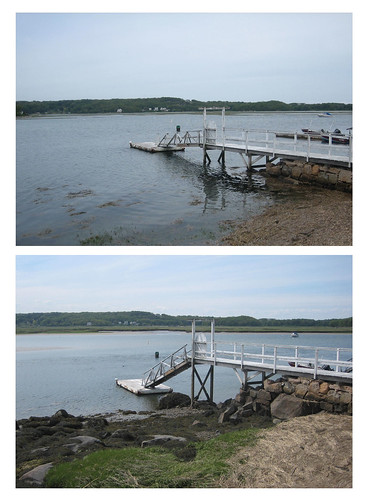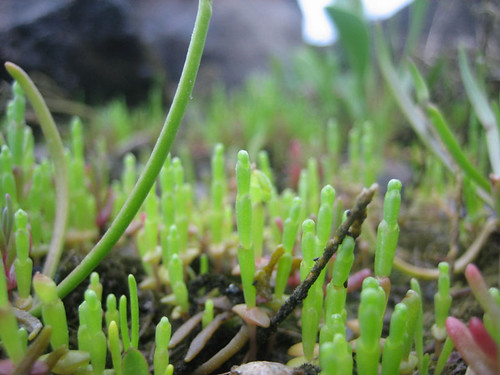Back when we were sea bean farmers ...
Earlier this summer, we spent a lovely week in a house on the Annisquam River in Gloucester. The Annisquam is tidal and feeds into the Atlantic, so the terrain changed four times a day.
The difference between high and low tide was about ten feet:

At low tide, we spent a lot of time on the tiny beach, discovering all kinds of interesting finds.
My dad was particularly interested in the live mussels that appeared under the dock. I admired his adventurousness, but this is a man who forages interesting fungi, fries them up for lunch, and then refers to identification guides. I pointed to a recent red tide warning, and suggested we look elsewhere for seafood.
And then we discovered the treasure at the bottom of the garden.
I've made mention here before about sea beans, salty, green-bean-like veggies occasionally found in WholeFoods for $10 a pound. (Luckily, a lightweight fistful goes a long way.)

One low-tide afternoon, I was checking out the tidepools when I spotted something familiar.

Sea beans! A whole field of them!
I dragged The Boy down to take a look, and he was equally impressed. We tried a couple — perfectly crunchy, salty, beany — and took some for my parents to sample.
The next day, we checked again — and there were more!

Sadly, that was also our last day, so we were unable to continue to track the speed or spread of their growth. Still, it's good to know these lovely little veggies grow wild in our area. Even if they are underwater most of the time.
The difference between high and low tide was about ten feet:

At low tide, we spent a lot of time on the tiny beach, discovering all kinds of interesting finds.
My dad was particularly interested in the live mussels that appeared under the dock. I admired his adventurousness, but this is a man who forages interesting fungi, fries them up for lunch, and then refers to identification guides. I pointed to a recent red tide warning, and suggested we look elsewhere for seafood.
And then we discovered the treasure at the bottom of the garden.
I've made mention here before about sea beans, salty, green-bean-like veggies occasionally found in WholeFoods for $10 a pound. (Luckily, a lightweight fistful goes a long way.)

One low-tide afternoon, I was checking out the tidepools when I spotted something familiar.

Sea beans! A whole field of them!
I dragged The Boy down to take a look, and he was equally impressed. We tried a couple — perfectly crunchy, salty, beany — and took some for my parents to sample.
The next day, we checked again — and there were more!

Sadly, that was also our last day, so we were unable to continue to track the speed or spread of their growth. Still, it's good to know these lovely little veggies grow wild in our area. Even if they are underwater most of the time.


